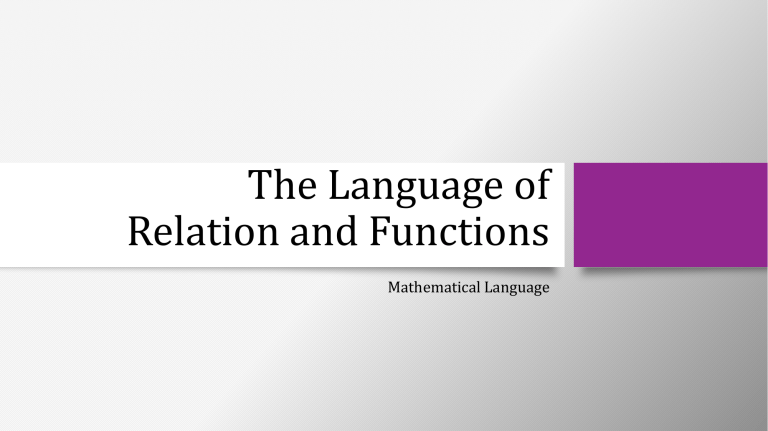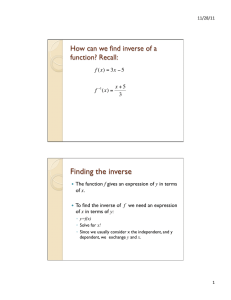
The Language of
Relation and Functions
Mathematical Language
RELATION
Relation
A relation is a set of ordered pairs.
If x and y are elements of these sets and if a relation exists between x
and y, then we say that x corresponds to y or that y depends on x and is
represented as the ordered pair of (x, y).
A relation from set A to set B is defined to be any subset of AB.
If R is a relation from A to B and (a, b) R, then we say that “a is related to b”
and it is denoted as a R b.
Relation
Let A {0, 1, 2} and B = {1, 2, 3}
Then AB gives all possible pairings of the elements of A and B.
AB = {(0, 1), (0, 2), (0, 3), (1, 1), (1, 2), (1, 3), (2, 1), (2, 2), (2, 3)}
Let us say the an element 𝑥 in A is related to an element 𝑦 in B if and
only if, 𝑥 is less than 𝑦.
R= {(0, 1), (0, 2), (0, 3), (1, 2), (1, 3), (2, 3)}
Relation
Example: Let us say the an element 𝑥 in 𝐴 is related to an element 𝑦
in 𝐵 if and only if, 𝑥 is less than 𝑦.
R = {(0, 1), (0, 2), (0, 3), (1, 2), (1, 3), (2, 3)}
▪
▪
▪
▪
▪
▪
0 R 1 since 0<1
0 R 2 since 0<2
0 R 3 since 0<3
1 R 2 since 1<2
1 R 3 since 1<3
2 R 3 since 2<3
R means “not related to”
𝑥 𝑅 𝑦 means the (𝑥, 𝑦) ∈ 𝑅
𝑥 𝑅 𝑦 means the (𝑥, 𝑦) ∉ 𝑅
Relation
Example: Let A = {1, 2} and B = {1, 2, 3} and define a relation R from A
to B as follows:
Given any 𝑥, 𝑦 ∈ 𝐴 × 𝐵,
𝑥, 𝑦 ∈ 𝑅 means that
x−y
2
is an integer.
𝐴 × 𝐵 = { 1, 1 , 1, 2 , 1, 3 , 2, 1 , 2, 2 , 2, 3 }
𝑹 = { 𝟏, 𝟏 , 𝟏, 𝟑 , 𝟐, 𝟐 }
True or False:
Is 1 𝑅 3?
Is 2 𝑅 3?
Is 2 𝑅 2?
True
False
True
Relation
Ways How to Write or Represent Relations
Example: R = {(-2, 1), (-2, 3), (0, -3), (1, 4), (3, 1)}
Tabular:
Graphical:
Mapping Diagram
(Arrow Diagram):
Relation
Let 𝐴 and 𝐵 be sets. A relation 𝑹 from 𝑨 to 𝑩 is a subset of 𝐴 × 𝐵. Given an
ordered pair (𝑥, 𝑦) in 𝐴 × 𝐵, 𝒙 is related to 𝒚 by 𝑹, written 𝑥 𝑅 𝑦, if, and
only if, (𝑥, 𝑦) is in 𝑅. The set 𝐴 is called the domain of 𝑅 and the set 𝐵 is
called the co-domain (image).
Example: A = {4, 7},
𝐴𝐴 = {(4, 4), (4, 7), (7, 4),(7, 7)}.
Let R on A be the description: x R y x + y is even.
Then (4, 4) R, and (7, 7) R.
R = { (4, 4), (7, 7)}
dom R = {4, 7}, im R = {4, 7}
Relation
Example: R = {(-2, 1), (-2, 3), (0, -3), (1, 4), (3, 1)}
dom R = {-2,0,1,3}, im R = {1, 3, -3, 4}
Example: R = {(0, 1), (0, 2), (0, 3), (1, 2), (1, 3), (2, 3)}
dom R = {0, 1, 2}, im R = {1, 2, 3}
FUNCTIONS
FUNCTIONS
A function 𝑭 from a set 𝑨 to a set 𝑩 is a relation with domain 𝐴 and
co-domain 𝐵 that satisfies the following properties:
✓ For every element 𝑥 in 𝐴, there is an element 𝑦 in 𝐵 such that
(𝑥, 𝑦) ∈ 𝐹.
✓ For all elements 𝑥 in 𝐴 and 𝑦 and 𝑧 in 𝐵, if (𝑥, 𝑦) ∈ 𝐹 and (𝑥, 𝑧) ∈ 𝐹,
then 𝑦 = 𝑧
FUNCTIONS
A function is a relation that for each input,
there is only one output.
Example 1:
Example2:
FUNCTION
FUNCTION
FUNCTIONS
Example 3:
Example 4:
FUNCTION
FUNCTION
FUNCTIONS
Example 5:
Example 6:
NOT a function
NOT a function
FUNCTIONS
Example 7:
NOT a function
Example 8:
NOT a function
What Makes a Relation a Function?
A function is actually a “special” kind of relation because it
follows an extra rule. Just like a relation, a function is also a set
of ordered pairs; however, every x-value must be associated to
only one y-value.
𝑦 = 𝑓(𝑥)
Dependent
variable
OUTPUT
Name of the
function
Independent
variable
INPUT
Graph of a Function
Given:
Graph:
Note: you can determine if a relation is a function by using
the vertical line test
FUNCTIONS
Constant Function
𝑓 𝑥 =𝑐
The c-value can be any number, so
the graph of a constant function is
a horizontal line.
Here is the graph of f(x) = 4
FUNCTIONS
Identity Function
𝑓 𝑥 =𝑥
For the identity function, the xvalue is the same as the y-value.
The graph is a diagonal line going
through the origin.
FUNCTIONS
Linear Function
𝑓 𝑥 = 𝑚𝑥 + 𝑏
An equation written in the slopeintercept form is the equation of a
linear function, and the graph of
the function is a straight line.
Here is the graph of 𝑓 𝑥 = 3𝑥 + 4
FUNCTIONS
Absolute Value Function
𝒇 𝒙 = 𝒙
The absolute value function is
easy to recognize with its Vshaped graph. The graph is in two
pieces and is one of the piecewise
functions.
Inverse Functions
An inverse function reverses the inputs with its outputs.
Given the function 𝑓 𝑥 = 3𝑥 − 4
𝑓 𝑥 =𝑦
The inverse of a function is denoted by the symbol 𝒇−𝟏 𝒙
𝒇−1
𝒙+4
𝒙 =
3
How do we solve for the Inverse of a Function?
Given : 𝑓 𝑥 = 3𝑥 − 4
re-write: 𝑦 = 3𝑥 − 4
Interchange the variables:
𝑥 = 3𝑦 − 4
Solve for y in terms of x:
3𝑦 = 𝑥 + 4
𝑥+4
𝑦=
3
Change 𝑦 to 𝑓 −1 (𝑥):
𝒙+4
−1
𝒇 𝒙 =
3
Function Operations
Addition of functions:
𝑓 𝑥 +𝑔 𝑥 =
𝑓+𝑔
𝑥
Subtraction of functions:
𝑓 𝑥 −𝑔 𝑥 =
𝑓−𝑔
𝑥
Multiplication of functions: 𝑓 𝑥 ∙ 𝑔 𝑥 =
Division of functions:
𝑓 𝑥
𝑔 𝑥
=
𝑓
𝑔
𝑥
𝑓∙𝑔
𝑥
Function Operations
Example1 :
Let 𝑓 𝑥 = 2𝑥 + 1 and 𝑔 𝑥 = 𝑥 2 − 4
(a) Find 𝑓 + 𝑔 𝑥
𝒇+𝒈 𝒙 =𝒇 𝒙 +𝒈 𝒙
(b) Find 𝑓 − 𝑔 𝑥
𝒇−𝒈 𝒙 =𝒇 𝒙 −𝒈 𝒙
= 2𝑥 + 1 + 𝑥 2 − 4
= 2𝑥 + 1 − 𝑥 2 − 4
= 𝒙𝟐 + 𝟐𝒙 − 𝟑
= −𝒙𝟐 + 𝟐𝒙 + 𝟓
Function Operations
1
1
𝑎𝑛𝑑 𝑔 𝑥 =
, 𝑡ℎ𝑒𝑛 𝑤ℎ𝑎𝑡 𝑖𝑠 𝑓 − 𝑔 𝑥 ?
Example 2 : 𝐼𝑓 𝑓 𝑥 =
𝑥−2
𝑥+2
𝑓 − 𝑔 𝑥 = 𝑓 𝑥 − 𝑔(𝑥)
1
1
=
−
𝑥−2 𝑥+2
𝑥+2−𝑥+2
=
𝑥−2 𝑥+2
𝑥+2 − 𝑥−2
=
𝑥−2 𝑥+2
𝟒
= 𝟐
𝒙 −𝟒
Function Operations
Example 3 : If 𝑓 𝑥 = 𝑥 2 + 𝑥 − 6 and 𝑥 =
1
, then what
𝑥+3
is 𝑓𝑔 𝑥 ?
𝑓𝑔 𝑥 = 𝑓 𝑥 𝑔(𝑥)
=
𝑥2
+𝑥−6
𝑥2 + 𝑥 − 6
=
𝑥+3
1
𝑥+3
𝑥−2 𝑥+3
=
𝑥+3
= 𝒙−𝟐
Function Operations
Example 4 :
𝑓 𝑥 = 𝑥−3
2
𝑎𝑛𝑑 𝑔 𝑥 = 5 − 𝑥 2 , what is 𝑓 − 𝑔 𝑥 ?
𝑓 − 𝑔 𝑥 = 𝑓 𝑥 − 𝑔(𝑥)
= 𝑥−3
2
− 5−𝑥
2
= 𝑥 2 − 6𝑥 + 9 − 25 − 10𝑥 + 𝑥 2
= 𝑥 2 − 6𝑥 + 9 − 25 + 10𝑥 − 𝑥 2
= 𝟒𝒙 − 𝟏𝟔
Function Operations
Composition of Functions:
𝑓 ∘ 𝑔 = 𝑓 𝑔(𝑥)
read as “𝑓 of 𝑔 of 𝑥"
It means that whenever there is an x in the function f, it is replaced with
the function g(x). The domain of 𝑓°𝑔 is the set of all x in the domain of g
such that g(x) is in the domain of f.
Example 1:
Let 𝑓 𝑥 = 𝑥 2 and 𝑔 𝑥 = 𝑥 − 3. Find 𝑓 𝑔 𝑥
𝑓 𝑔(𝑥) = 𝑓 𝑥 − 3
= 𝑥−3
2
= 𝒙𝟐 − 𝟔𝒙 + 𝟗
Composition of Functions:
Example 2:
𝑓 ∘ 𝑔 = 𝑓 𝑔(𝑥)
Let 𝑓 𝑥 = 2𝑥 − 1 and 𝑔 𝑥 = 𝑥 + 2. Find 𝑓 𝑔 𝑥
𝑓 𝑔 𝑥
= 𝑓 2𝑥 − 1
=2 𝑥+2 −1
= 2𝑥 + 4 − 1
= 𝟐𝒙 + 𝟑
Composition of Functions:
𝑓 ∘ 𝑔 = 𝑓 𝑔(𝑥)
Example 3: Let 𝑓 𝑥 = 3𝑥 + 1 and 𝑔 𝑥 = 2𝑥 − 3. Find 𝑓 𝑔 𝑥
𝑓 𝑔 𝑥
= 𝑓 2𝑥 − 3
𝑔 𝑓 𝑥
and 𝑔 𝑓 𝑥
= 𝑔 3𝑥 + 1
= 3 2𝑥 − 3 + 1
= 2 3𝑥 + 1 − 3
= 6𝑥 − 9 + 1
= 6𝑥 + 2 − 3
= 𝟔𝒙 − 𝟖
= 𝟔𝒙 − 𝟏
HOME WORK #5
A. Give the domain and range of each relation
Domain
Range
1. 1,2 , 5,0 , 0, −2 , −3,4
_________________ __________________
2. −4,6 , 4,0 , −3, −1 , 5,2
_________________ __________________
3. 0,4 , −5,1 , −3, −2 , 3, −5
_________________ __________________
4. 1,2 , 2,3 , 3,4 , 4,5
_________________ __________________
5. 1,3 , 0,3 , 2,1 , 4,2
_________________ __________________
HOME WORK #5
B. Determine if the given mapping is a Functions or Not a Function
6.
7.
HOME WORK #5
B. Determine if the given mapping is a Functions or Not a Function
8.
9.
HOME WORK #5
B. Determine if the given mapping
is a Functions or Not a Function
10.
C. Given: 𝑓 𝑥 = 2𝑥 + 7 and 𝑔 𝑥 = 3𝑥 + 1
Perform the indicated operations
11. 𝑓 𝑥 + 𝑔 𝑥
12. 𝑓 𝑥 − 𝑔 𝑥
13. 𝑓 𝑔 𝑥
14. 𝑔 𝑓(−2)
15. 𝑓 5 + 𝑔 −3


